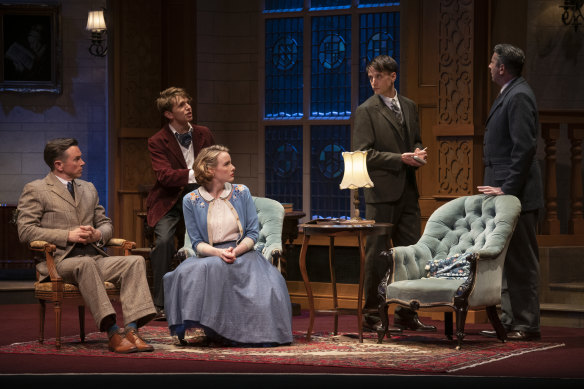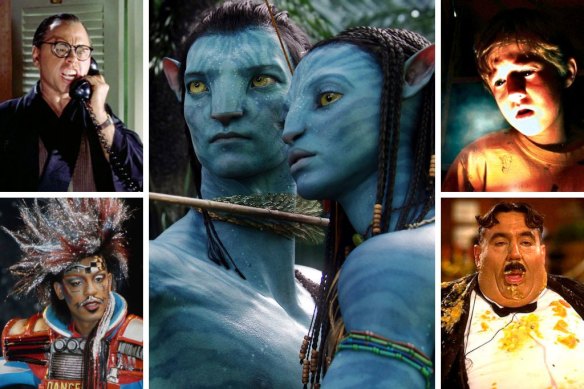Other shows could learn a thing or 10 from The Mousetrap.
At a spritely 71, Agatha Christie’s The Mousetrap wears its years well. Barring a little pandemic break, it’s been entertaining the West End non-stop since 1952, and returns to the local stage this month as part of a 70th anniversary tour. You can’t say the same of other plays of its vintage – few people have even heard of the likes of Come On, Jeeves or I’ve Got Sixpence.
So what’s the secret to art ageing gracefully? These top 10 tips might help …
Alex Rathgeber, Laurence Boxhall, Anna O’Byrne, Tom Conroy and Adam Murphy in a scene from The Mousetrap.Credit:Brian Geach
Own your grey …
The Mousetrap is theatre’s little black dress – it’s simple, effective, and essentially hasn’t changed since it premiered. It doesn’t date because it wasn’t particularly on-trend to begin with. Instead, it’s set in the same fictional version of England that so many genteel murder mysteries are, making it both nostalgic and timeless. Any work of art that tries too hard to be relevant to its era runs the risk of going out of fashion – we haven’t forgotten you, Starlight Express.
… or update your style
Another way to avoid seeming dated is to be endlessly updateable. Want to set Much Ado on a singles cruise ship? What about Medea x Bluey? The Importance of Being Earnest as a biker burlesque? If artists can reinterpret your work to suit changing times, you’ll never be shelved forever. Just look at music and its endless recycling of the past, or the cycle of reboots dominating our screens.
Avoid an overprocessed diet
When it comes to film, relying on special effects is one of the fastest ways to go from hero to zero. There’s an entire suite of turn-of-the-millennium movies that are virtually unwatchable now that we carry better-quality image processors in our pockets. James Cameron might be gambling against this, but the films that have aged best lean more heavily on story, performance and craft over technical gimmickry. When Harry Met Sally, The Godfather and The Piano look like they could have been made today, whereas even Avatar is a little creaky at the hinges.
Set a trend without being a trend
The twist ending of M. Night Shyamalan’s The Sixth Sense made him a household name, but as he kept churning out the surprise climaxes he quickly became a punchline. If your work spawns hordes of imitators, don’t risk becoming one of them.
Ageing badly (clockwise from bottom left): Starlight Express; Breakfast at Tiffany’s; Avatar; The Sixth Sense; Monty Python’s The Meaning of Life.Credit:
Dance like (almost) nobody’s watching
Riding the winds of popular favour is a tricky business. Today’s mumbling Soundcloud rappers and sad-girl singer-songwriters might well go the way of the Fat Boys and Enya. Cultivate instead a small but cultishly devoted following, and loyalty will keep you afloat for longer. That’s why bands like Bikini Kill and Soul II Soul can travel halfway around the world to play Melbourne in 2023. Even megastars like Taylor Swift afford their fans the sense that they’re part of an exclusive club.
Be talked about
Some artworks go the Paris Hilton route: they’re famous for being famous. The easiest way to make a splash is to shock, offend or bewilder, but once enough people are talking about your work, the work itself barely matters. Almost nobody actually performs John Cage’s silent composition 4′33″ or dresses in vintage Vivienne Westwood – but the legends have rendered their names in stone.
Lose the edge
Bad art can make you laugh, but edgy art will eventually make you cringe. It’s like a self-proclaimed cool dad – if it thinks it’s pushing the envelope, doesn’t have a filter, is saying the stuff no one else dares, it’s probably just doing Ricky Gervais impressions circa 2010. The pit of cultural detritus that was once considered edgy is a deep one, containing the likes of the Monty Python boys, Robin Thicke and all of Kevin Smith’s back catalogue.
Don’t be a weathervane
It’s easy to say they’re products of their time, but it’s also really hard to digest the kinds of casual racism that run through once-revered works such as Gone with the Wind, Breakfast at Tiffany’s and John Hughes’ Sixteen Candles. There’s rampant misogyny and homophobia and all kinds of other mean-spiritedness throughout any canon of art, and there’s perhaps nothing that dates as badly as that.
Rediscover your inner child
If you scan the history of pop, it’s astonishing how many bangers have something to appeal to a toddler. The song might speak directly to their interests (Girls Just Wanna Have Fun, Starman, Bad Guy, Eye of the Tiger) or just recognise where they’re at (the stomp-stomp-clap of We Will Rock You, the Gangnam Style dance, the skyscraper choruses of Firework and Wrecking Ball and anything from the Trolls soundtrack). You can play a kindergartener pretty much anything by ABBA or the Jackson 5 or Imagine Dragons and they’ll get it; even the Beatles have a surprise amount of stuff with the same age rating as Octopus’s Garden.
Never say never
You can’t say that this preponderance of kid-friendly fare is due to children setting the standard of timeless art. It might be, rather, that it’s connected to something that runs throughout the above list: a denial of death. Classic pop feels outside of time, just like The Mousetrap does. Great movies and books and paintings and sculptures feel fresh and relevant decades after their making, and in that way they might transfer to their viewers a little of that aura of immortality. It might be too big a call, but consider the opposite case. When you revisit something you once cherished only to find it has dated horribly? Whatever your age, that just makes you feel old.
The Mousetrap is at The Comedy Theatre from February 17.
A cultural guide to going out and loving your city. Sign up to our Culture Fix newsletter here.
Most Viewed in Culture
From our partners
Source: Read Full Article



